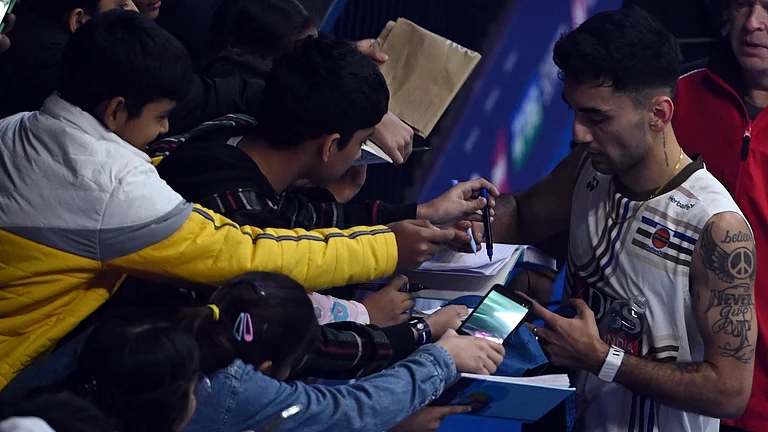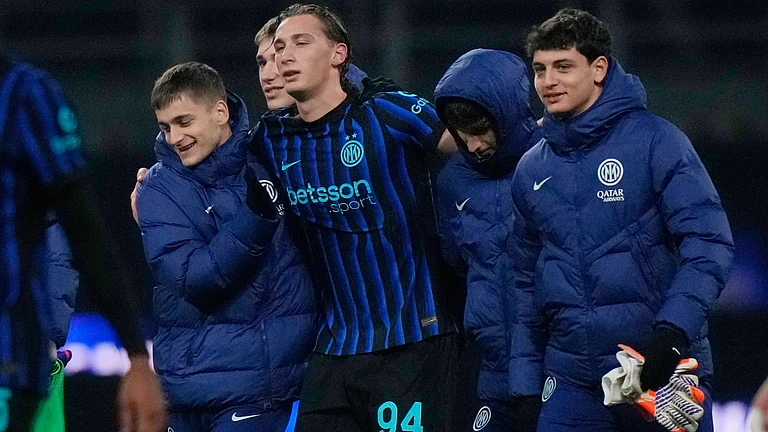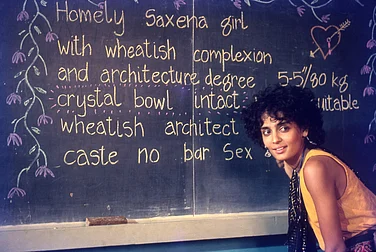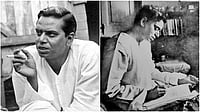‘Master log pagla gaya hai, bol raha tha dharti aakash mein latka hua hai’. (Flings slippers in the air and they fall). ‘Yeh dekh, chappal to neeche gir gayi na, yeh to nahin latki aakash mein’—screams an angry, indignant, confused eight-year-old Bhola (Satendra Soni) to his nonplussed, innocent, religious, illiterate mother (Masumeh), after being explained that the world is a part of the solar system in space, and not resting on sheshnag’s head as mentioned in a Hindu religious lore.
It is one of the many critical conflicts of blind faith versus rationality and science that a new film ‘Ab Toh Sab Bhagwaan Bharose’ brings to life.
Shiladitya Bora’s remarkably brave film throws light on indoctrination by the aggressive Right-wing Hindus at the onset of the Ram Janmabhoomi movement. Staged in a village in Uttar Pradesh in 1989, the film unpacks the intersection of poverty, lack of education, systematic transmission of religion (Mahabharata telecast on TV—a miracle then), belief, indoctrination of just one interpretation and forced supremacy of Hinduism.
A collective that insists on basing life on religion can do many things. It builds disbelief in the rational and allows people to be maneuvered, which makes them believe that they themselves will be the protectors of faith. It slowly constructs atheists and rational minds to be threats, and they consider themselves to be the custodians of the Hindu practice which projects Brahmins as beacons—both of education and of society. In a world where questions and debates are demonised and rational thought defeated at the hands of aggressive belief, this film unpacks each of these connections through very sensitive writing.
Everything that we live through today is a repercussion of one of the deepest fault lines created then by the predecessors of the oppressive regime we are governed by today.
Arguably one of the most condemnable acts in modern Indian history was the tearing down Babri Masjid, which changed the landscape of Indian politics forever. The mandir (temple) promised then, which we are watching being constructed now, is being built on the embers of a burnt democracy. The film follows the rise of that aggression, and how it corrupts innocent minds into believing and finding their higher purpose in the defense of faith.
With a child at the centre of this tumultuous time, the film showcases what bright, innocent minds go through, and are put through with consistent stimuli of only one kind of narrative—Hindu supremacy that demonises a Muslim village and community as ‘asurs’, how there is a question on ‘how’ there can be another God anyone else worships because God must only be one, and the one God is the one that belongs to the Hindus, how everything can be solved by just worshipping a God, and how just coincidences build narratives in impressionable human minds.
A film and script like this is deeply aware of its gaze. A third person viewing that is strikingly personal, set in the languid village that not once favours any narrative. It holds a mirror and allows the viewer to experience the indoctrination first hand. They lament several lost opportunities of intervention—how adults irresponsibly spout religious stories and it is their own biases laced in those interpretations that young minds believe instantaneously. How any one incident can be a tipping point enough for an innocent mind to believe in the idea that there is a saviour who can solve everything, who eventually too needs protection. How the child feels validated with a sense of purpose as he donates all he has to building a Ram mandir believing he is better than the bus driver fighting this unnecessary pressure to donate for a mandir not needed, but a road that is.
These scenes in the film are critically nuanced, allowing us to watch the world through Bhola’s very innocent eyes. In an unimaginably brilliant turn as Bhola, Soni’s angst, his internal conflict between what he is taught and what he is asked to believe by those he loves, is palpable. The beauty, softness, and open landscape of the village are in sharp contrast with the turmoil the film attempts to showcase, with us, the audience, hoping that innocent spaces would be spared the heat of scorching hate.
Organised religion with politics and funds can change social structures forever. Narratives that demonise democratic thought, rational thinking, and any space for mutual co-existence of the ‘other’ that leads to the desire of ethnic cleansing is linearly and cleanly depicted in the film. As is unridled rage in a young boy, enough to want to kill another of a different religion.
The timing of this film couldn’t be better. Since we are witnessing and living through an even more aggressive, consistent version of what was designed 1989 onwards. The film insists that we look at what is being done around us, watch the same tactics repeated for what can only result in bloodbath yet again. We are watching as democratic thought is curtailed, and rationality imprisoned. As the 2024 elections inch closer, it is imperative that cinema too does what this film is doing. Implore us to think, question, and reason.
The fact that the film managed a clearance from the censors today is a surprise. However, muting of certain dialogue goes to show that censors are refusing to recognise the intensity and ease with which hate is spread. Don’t mute the reality. Instead help change it.
Do watch this very important film.
(Saumya Baijal is a bilingual writer, ad woman, storyteller, poet, theatre person and activist. Views expressed are personal)


























